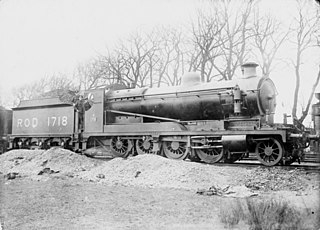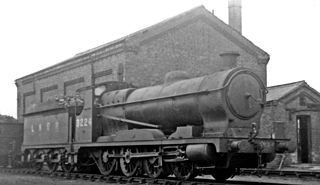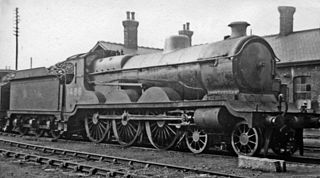Related Research Articles
John George Robinson CBE, was an English railway engineer, and was chief mechanical engineer of the Great Central Railway from 1900 to 1922.

The London and North Eastern Railway (LNER) Class B17, also known as "Sandringham" or "Footballer" class was a class of 4-6-0 steam locomotive designed by Nigel Gresley for hauling passenger services on the Great Eastern Main Line. In total 73 were built.

The Railway Operating Division (ROD) ROD 2-8-0 is a type of 2-8-0 steam locomotive which was the standard heavy freight locomotive operated in Europe by the ROD during the First World War.
Alexander Henderson, 1st Baron Faringdon, known as Sir Alexander Henderson, 1st Baronet, from 1902 to 1916, was a British financier and Liberal Unionist Member of Parliament.

The NER Class X was a class of 4-8-0T tank locomotive designed by Wilson Worsdell for the North Eastern Railway. They were intended for use as powerful shunting engines to arrange and move coal wagons for loading into ships. In total 15 were built, 10 by the NER between 1909 and 1910, and a further five in 1925 by the London and North Eastern Railway (LNER). They had three cylinders with divided drive: the inside cylinder driving the leading axle, the outside cylinders driving the centre.

The Great Central Railway (GCR) Class 8A was a class of 0-8-0 steam locomotive built between 1902 and 1911 for handling heavy coal trains over the Pennines. They all passed to the LNER in 1923, who redesignated them Class Q4. They were withdrawn from service between 1934 and 1951.

The GCR Class 1B was a class of 2-6-4T (tank) locomotives on the Great Central Railway. They were notable as the first locomotives of the 2-6-4T wheel arrangement to be used by a British standard-gauge railway; there had been two narrow-gauge examples on the Leek & Manifold Valley Light Railway since 1904.
Robert Absalom Thom was the final Locomotive, Carriage and Wagon Superintendent of the Lancashire, Derbyshire and East Coast Railway, and became a key figure in the locomotive departments of the company's successors, the Great Central Railway and the London & North Eastern Railway. Thom was born at Aberdeen on 14 June 1873. He attended Robert Gordon's College in Aberdeen, where he received a technical education.
Although overshadowed by the later and more famous steam locomotives that John G. Robinson would go on to design, the Great Central Railway Class 11B 4-4-0 Express Passenger engines were a successful class which totalled 40. Built from 1901 to 1903, in later rebuilt form as 11D, some 11Bs would last in service until 1950. Railwaymen continued to refer to the class as "11B" even after all were rebuilt to 11D. Being contemporary with and to some extent the 4-4-0 version of Robinson's much more numerous 0-6-0 goods class 9J, which were known as "Pom-Poms", the 11Bs acquired the nickname "Pom-Pom Bogies". The London & North Eastern Railway classified the 11Bs, along with their 11C and 11D rebuilds, as Class D9.
The LD&ECR Class D was a class of nine 0-6-4T steam locomotives supplied to the Lancashire, Derbyshire and East Coast Railway in 1904 and 1906 by Kitson & Co. of Leeds. They later became the property of the Great Central Railway and finally the London and North Eastern Railway, upon which they were known as Class M1.

The GCR Class 11E was a type of 4-4-0 steam locomotive used by the Great Central Railway for express passenger services. Ten were built in the railway's own workshops at Gorton, Manchester during 1913; they remained in service until the mid-1950s.

The NBR 224 and 420 Classes consisted of six steam locomotives of the 4-4-0 wheel arrangement built by the North British Railway (NBR) in 1871 and 1873. No. 224 had three claims to fame: it was the first inside-cylinder 4-4-0 engine to run in Great Britain; it was the locomotive involved in the Tay Bridge disaster; and after rebuilding in 1885, it was the only compound-expansion locomotive on the NBR, and one of just three tandem compounds in Britain.
The GCR Class 8C was a class of a pair of 4-6-0 locomotives built for the Great Central Railway in 1903–1904 by Beyer, Peacock and Company. They passed to the London and North Eastern Railway at the 1923 grouping and received the classification B1 They were reclassified B18 in 1943 and both were retired in 1947.

The GCR Class 8B was a class of 27 two-cylinder steam locomotives of the 4-4-2 wheel arrangement built between 1903 and 1906 for the Great Central Railway. They were nicknamed "Jersey Lillies" after the famous music star Lillie Langtry.
GCR Class 8G was a class of 10 two-cylinder steam locomotives of the 4-6-0 wheel arrangement built in 1906 for the Great Central Railway.
The NBR 141 Class consisted of two steam 2-4-0 locomotives built by the North British Railway (NBR) in 1869. They were the direct antecedents of the NBR 224 Class 4-4-0.
GCR Class 9P was a design of four-cylinder steam locomotive of the 4-6-0 wheel arrangement built for hauling express passenger trains on the Great Central Railway in England. A total of six were built: one in 1917, and five in 1920. They were sometimes known as the Lord Faringdon class, from the name of the first one built.

The GCR Class 8F was a class of ten 4-6-0 locomotives built for the Great Central Railway in 1906 by Beyer, Peacock and Company to the design of John G. Robinson for working fast goods and fish trains. They passed to the London and North Eastern Railway at the 1923 grouping and received the classification 'B4'.
The Great Central Railway Class 8N - London North Eastern Railway Class B6 - was a class of three 4-6-0 steam locomotives, designed by John G. Robinson in 1918. They were a mixed traffic class. All three examples were withdrawn in November and December 1947.
The NER Class Z was an Atlantic class of locomotives designed by Vincent Raven. It was introduced in 1911.
References
- Boddy, M.G.; Fry, E.V.; Hennigan, W.; Proud, P.; Yeadon, W.B. (July 1963). Fry, E.V. (ed.). Locomotives of the L.N.E.R., part 1: Preliminary Survey. Potters Bar: RCTS.
- Boddy, M. G.; Brown, W. A.; Fry, E. V.; Hennigan, W.; Hoole, Ken; Manners, F.; Neve, E.; Platt, E. N. T.; Russell, O.; Yeadon, W. B. (November 1979). Fry, E. V. (ed.). Locomotives of the L.N.E.R., Part 3A: Tender Engines—Classes C1 to C11. Kenilworth: RCTS. ISBN 0-901115-45-2.
- Dow, George (1965). Great Central, Volume Three: Fay Sets the Pace, 1900-1922. Shepperton: Ian Allan. ISBN 0-7110-0263-0.
- Haresnape, Brian; Rowledge, Peter (May 1982). Robinson Locomotives: A Pictorial History. Shepperton: Ian Allan. ISBN 0-7110-1151-6. DX/0582.
- Jackson, David (1996). J.G. Robinson: A Lifetime's Work. The Oakwood Library of Railway History. Headington: Oakwood Press. ISBN 0-85361-497-0. OL98.
- van Riemsdijk, John T. (1994). Compound Locomotives: An International Survey. Penryn: Atlantic Books. ISBN 0-906899-61-3.